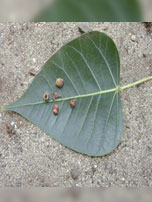SHAHEED
KARTAR
SINGH
SARABHA
A Y U R V E D I C M E D I C A L C O L L E G E & H O S P I T A L
Affiliated to Guru Ravidas Ayurved University, Hoshiarpur Punjab
Affiliated to Guru Ravidas Ayurved University, Hoshiarpur Punjab

Botanical Name: Ficus religiosa Linn.
Family: Moraceae
Introduction :
Relijosa = holy sacred.
Scientific classification: Figs constitute the genus Ficus, of the family Moraceae. The common commercial fig is classified as Ficus carica,the sycamore fig as ficus sycomorus, and the pipal, or sacred fig, asFicus religiosa. The common rubber plant is classified as Ficus elastica,and the banyan tree, or Indian fig, as Ficus bengalensis. The two figs native to the subtropical United States are classified as Ficus aurea andFicus citrifolia
Fig, common name for plants of a genus of the mulberry family, and for the fruits of these plants. The common commercial fig, native to southwest Asia, is widely cultivated in tropical and subtropical countries. It is a low, deciduous tree, about 5 to 8 m (about 15 to 25 ft) tall, having deeply lobed, alternate leaves that are rough above and smooth beneath; branches are covered with downy, greenish bark.
The small flowers of the fig plant are borne on the inner surface of a fleshy, hollow organ called a receptacle, and the fruit is the result of further growth of the receptacle. Many commercial fig varieties produce no fertile pollen, and as fruit development cannot proceed without fertilization, pollen of the wild fig is used for these varieties. Fruits of other varieties develop without fertilization.
Names in different Indian languages :
English : Peepal,Bot-tree,sacred fig
Hindi : Pippal, pipar
Kannada : Aswaththa
Malayalam : Aryal
Sanskrit : Ashvattha,pippalah
Tamil : Arasu,Ashvatham.
Telugu : Ravi
Unani : Peepal
Synonyms :
Ashvattha, Bodhidru, Bodhivrkisha, Sebya, Chalapatra, Gajabhaksha, Kshiradruma, Peeppal.
Morphology :
Tree is very huge and tall. In old trees the bark cracks. Leaves- soft shiny, heart shaped with 5-7 veins and pointed tip. Because of this arrangement with a slight wind the leaves shake. (It is said that when the leaves of pipal are still, it is assumed there is no wind). Fruits – small round green when raw and red when ripe. Fruits appear in summer and ripe in monsoon, Old pipal tree produces a sealing wax which is known as krimi). A very small quantity of secretions falls on the ground from pipal tree. Hindus and especially Buddhists consider pipal tree as a very sacred tree
Distribution & Habitat :
Throughout India
Chemical constituents :
beta-sitosteryl-Dglucoside. Vitamin K, n-octacosanol, methyl oleanolate, lanosterol, stigmasterol, lupen-3-one, tannins
Properties :
Guna : guru, ruksha;
Rasa : kashaya;
Vipaka : katu;
Veerya : sheeta
Karma : Hridyam, vishaghna, raktadosha, kushtaghna
astringent, antiseptic, laxative, haemostatic, vaginal disinfectant
Indication :
Kusta, daha, kasa, swasa, yonidosha,menorrhagia, metrorrhagia, blood dysentery, bleeding piles, haematuria and haemorrhages, diabetes, diarrhoea, leucorrhoea, nervous disorders, skin diseases
Part used :
Bark, leaves, fruits, latex
Dosage :
Leaf juice 10-15 ml
Powder 2-4 g
Decoction 50-100 ml
External uses :
Complexion enhancer – paste of aerial roots is applied locally. The powder of bark is sprinkled on the wounds. its latex is useful in reducing pain and swelling and also acts as haemostatic.
Internal uses :
Being astringent bark is used in vomiting, diarrhoea, dysentery. Ripe fruits of pipal are used in stomachache and constipation. In diabetes fruits and bask are used, Decoction of the bark + honey and 6,iits are useful in gout, blood disorders and bleeding disorders, powdered dry fruits are given for conception. Emits, roots, bark and aerial roots processed in mills- sugar + honey is prescribed as an aphrodisiac. (Infertile couples are advised to worship pipal tree). Bark,fruits and leaves are used for medicinal purpose.